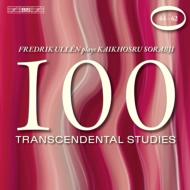100 Transcendental Studies, Nos. 44–62
Fredrik Ullén (piano)
BIS Records: BIS-CD-1713 (2010)
Web page for BIS RecordsWeb page for BIS Records BIS-CD-1713
 Duration: 80:25
Comments: The third volume of Ullén’s complete survey of the 100 Transcendental Studies. This CD contains studies 44–62.
Duration: 80:25
Comments: The third volume of Ullén’s complete survey of the 100 Transcendental Studies. This CD contains studies 44–62.See Fredrik Ullén’s list of comments on most of Sorabji’s 100 Études transcendantes and a summary table of all known first performances of individual études.
Track listing
- Track 1: 100 Transcendental Studies 44. Ben cantato. Dolce e chiaro (15:25)
- Track 2: 100 Transcendental Studies 45. — (1:26)
- Track 3: 100 Transcendental Studies 46. — (2:44)
- Track 4: 100 Transcendental Studies 47. Leggiero e a capriccio (2:35)
- Track 5: 100 Transcendental Studies 48. Volante (3:14)
- Track 6: 100 Transcendental Studies 49. Vivace ma non troppo (2:23)
- Track 7: 100 Transcendental Studies 50. Per il pedale 3 (4:50)
- Track 8: 100 Transcendental Studies 51. — (3:15)
- Track 9: 100 Transcendental Studies 52. — (3:14)
- Track 10: 100 Transcendental Studies 53. A capriccio (1:59)
- Track 11: 100 Transcendental Studies 54. — (4:17)
- Track 12: 100 Transcendental Studies 55. — (2:43)
- Track 13: 100 Transcendental Studies 56. Moderato (3:10)
- Track 14: 100 Transcendental Studies 57. — (2:02)
- Track 15: 100 Transcendental Studies 58. Leggiero (3:31)
- Track 16: 100 Transcendental Studies 59. Quasi fantasia. Moderato (10:46)
- Track 17: 100 Transcendental Studies 60. Saltando, leggiero (3:07)
- Track 18: 100 Transcendental Studies 61. — (4:12)
- Track 19: 100 Transcendental Studies 62. — (2:37)
Reviews
- “The more we hear of Sorabji’s music the more it becomes apparent that the breadth of his expressive voice, and the extent to which he never repeated himself despite his prolific production of frequently vast works over an unusually long creative life (about 70 years), were truly extraordinary. As the 100 Studies progress, two things become apparent; that the inexhaustible wealth of invention contained here could have allowed him to produce a set of 343 had he had a mind to; and that as the cycle developed he seems to have become more interested in the music; there are progressively fewer pieces that sound as though they were written with mainly didactic intent, though the ones that do concentrate on specific Sorabjian figurations, scales and intervals (by this stage generally progressing through a series of different intervals rather than sticking with just one) certainly qualify as study material that would be a valuable addition to any pianist’s arsenal of technique-honing material. Even the shortest, fast pieces with specific technical challenges sound more like characteristic scherzi than studies per se. The previous volume had one strategically-positioned extended nocturne-like piece; this has two - the first a Jardin parfumé-like entanglement of viny melismas, the other an increasingly dense impressionistic fantasia. ” (Records International)
